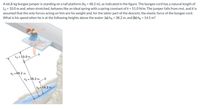
College Physics
11th Edition
ISBN: 9781305952300
Author: Raymond A. Serway, Chris Vuille
Publisher: Cengage Learning
expand_more
expand_more
format_list_bulleted
Concept explainers
Topic Video
Question

Transcribed Image Text:A 66.8-kg bungee jumper is standing on a tall platform (ho = 48.2 m), as indicated in the figure. The bungee cord has a natural length of
Lo = 10.0 m and, when stretched, behaves like an ideal spring with a spring constant of k = 51.0 N/m. The jumper falls from rest, and it is
assumed that the only forces acting on him are his weight and, for the latter part of the descent, the elastic force of the bungee cord.
What is his speed when he is at the following heights above the water: (a) ha = 38.2 m, and (b) hg = 14.5 m?
-A
Lo =10.0 m
ho =48.2 m
hA = 38.2 m
hp =14.5 m
Expert Solution
This question has been solved!
Explore an expertly crafted, step-by-step solution for a thorough understanding of key concepts.
Step by stepSolved in 2 steps with 2 images

Knowledge Booster
Learn more about
Need a deep-dive on the concept behind this application? Look no further. Learn more about this topic, physics and related others by exploring similar questions and additional content below.Similar questions
- I have tried this problem several times how do I do it correctly?arrow_forwardk AX A 0.40 kg block is pushed against a spring (k = 7.0 N/m) thereby compressing it by 25.0 cm, as shown in the figure above. After it is released the block travels a total distance of 23.3 cm before coming to rest. What is the coefficient of kinetic friction for the horizontal surface?arrow_forwardA vertical ideal spring, spring constant k, is compressed a distance A. A mass m is placed on top of the spring and then released. a) How high will the mass go? Н y=0 y=0 Answer: b) If instead the force exerted by the spring is given by F= -(ky+b), how high will the mass go?arrow_forward
- A block with a mass 3.7 kg is sitting on a frictionless ramp with a spring at rhe bottom that has a spring constant of 540 N/m. The angle of the ramp in respect to the horizontal is 36 degrees. 1) the block starts from rest and slides down the ramp a distance of 69cm before hitting the spring. how far is the spring compressed as the block comes to momentary rest? 2) after the block comes to rest the spring pushes the block back up the ramp. how fast is the block moving right after it comes off the spring. 3) what is the change in gravitational potential energy between the original positiion of the block at the top of the ramp and the position of the block when the spring is fully compressed?arrow_forwardPhysics Problem: A 2.5-kg block moving at 2. 0 m/s collides with a spring whose spring constant is390 N/m, as shown in the figure. The block compresses the spring a distance of 7.5 cm from itsequilibrium position and comes to a stop. What was the initial height of the block?(a) if the ramp exerts no friction force on the block.(b) if the coefficient of kinetic friction between the block and the horizontal surface is 0.25arrow_forwardA 6.50 ✕ 105 kg subway train is brought to a stop from a speed of 0.500 m/s in 0.400 m by a large spring bumper at the end of its track. What is the force constant k of the spring (in N/m)? (Enter a number.)arrow_forward
- A toy car of mass 2.0 kg starts at the top of an incline of angle 20.°. It travels 1.0 meter down the incline to a flat surface where it encounters a spring of spring constant, k = 5.0 N/m. (a) What is the car's speed at the bottom of the incline? (b) When the car encounters the spring, by how much does it compress (max) it? (c) The spring is removed and the car now encounters a second incline as shown. What is the maximum distance the car travels up this second incline?arrow_forwardA glider is placed at the top of an air track that is tilted at an angle of 7.7º from the horizontal. If the glider is then let go (from rest), what is its speed at the instant it has glided 0.275 mm along the track?arrow_forwardA spring with spring constant of 100 N/m launches a 20 g ball verticallyn into the air. If the ball reaches a height of 20 m, determine the original compression distance of the spring.arrow_forward
arrow_back_ios
arrow_forward_ios
Recommended textbooks for you
 College PhysicsPhysicsISBN:9781305952300Author:Raymond A. Serway, Chris VuillePublisher:Cengage Learning
College PhysicsPhysicsISBN:9781305952300Author:Raymond A. Serway, Chris VuillePublisher:Cengage Learning University Physics (14th Edition)PhysicsISBN:9780133969290Author:Hugh D. Young, Roger A. FreedmanPublisher:PEARSON
University Physics (14th Edition)PhysicsISBN:9780133969290Author:Hugh D. Young, Roger A. FreedmanPublisher:PEARSON Introduction To Quantum MechanicsPhysicsISBN:9781107189638Author:Griffiths, David J., Schroeter, Darrell F.Publisher:Cambridge University Press
Introduction To Quantum MechanicsPhysicsISBN:9781107189638Author:Griffiths, David J., Schroeter, Darrell F.Publisher:Cambridge University Press Physics for Scientists and EngineersPhysicsISBN:9781337553278Author:Raymond A. Serway, John W. JewettPublisher:Cengage Learning
Physics for Scientists and EngineersPhysicsISBN:9781337553278Author:Raymond A. Serway, John W. JewettPublisher:Cengage Learning Lecture- Tutorials for Introductory AstronomyPhysicsISBN:9780321820464Author:Edward E. Prather, Tim P. Slater, Jeff P. Adams, Gina BrissendenPublisher:Addison-Wesley
Lecture- Tutorials for Introductory AstronomyPhysicsISBN:9780321820464Author:Edward E. Prather, Tim P. Slater, Jeff P. Adams, Gina BrissendenPublisher:Addison-Wesley College Physics: A Strategic Approach (4th Editio...PhysicsISBN:9780134609034Author:Randall D. Knight (Professor Emeritus), Brian Jones, Stuart FieldPublisher:PEARSON
College Physics: A Strategic Approach (4th Editio...PhysicsISBN:9780134609034Author:Randall D. Knight (Professor Emeritus), Brian Jones, Stuart FieldPublisher:PEARSON

College Physics
Physics
ISBN:9781305952300
Author:Raymond A. Serway, Chris Vuille
Publisher:Cengage Learning

University Physics (14th Edition)
Physics
ISBN:9780133969290
Author:Hugh D. Young, Roger A. Freedman
Publisher:PEARSON

Introduction To Quantum Mechanics
Physics
ISBN:9781107189638
Author:Griffiths, David J., Schroeter, Darrell F.
Publisher:Cambridge University Press

Physics for Scientists and Engineers
Physics
ISBN:9781337553278
Author:Raymond A. Serway, John W. Jewett
Publisher:Cengage Learning

Lecture- Tutorials for Introductory Astronomy
Physics
ISBN:9780321820464
Author:Edward E. Prather, Tim P. Slater, Jeff P. Adams, Gina Brissenden
Publisher:Addison-Wesley

College Physics: A Strategic Approach (4th Editio...
Physics
ISBN:9780134609034
Author:Randall D. Knight (Professor Emeritus), Brian Jones, Stuart Field
Publisher:PEARSON